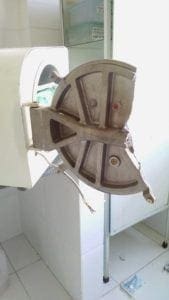Improve Autoclave Safety: Five Best Practices for 2020
By: Priorclave North America
Categories: Health & Safety Lab Autoclaves
People doing their everyday jobs sometimes forget the power of the tools they use. You become inured to their risks, and go on autopilot. Those are the moments where accidents happen. Autoclaves exert pressurized heat of more than 250 degrees and 20 pounds of pressure to do their jobs to sterilize. It’s those very same powers that present dangers if your lab setup, ergonomics, or machinery are suboptimal. With their high heat and pressure, maximizing autoclave safety is top priority. Although explosions are a concern in labs using any pressurized or highly heated equipment, scalding and burns can be significant—and much more common—day-to-day dangers for lab workers.

A dental autoclave explosion aftermath
Luckily, you can avoid most autoclave accidents with thoughtful planning, the right equipment, and rigorous training in safety protocols and procedures.
Improve Autoclave Safety by Planning Ahead
These five best practices top our 2020 safe practices list:
- Implement rigorous staff training: Be sure technicians wear personal protective equipment (PPE). Establish pauses in workflows for timely cooling/decompression. Keep regular records so staff always know what they’re working with when loading/unloading.
- Consistently wear personal protective equipment—every time!: Buttoned lab coats, rubber aprons when handling hot liquids, heat-resistant gloves, and safety glasses—especially when you’re going to “just grab something.” Accidents happen when we hurry. Each piece of PPE serves its own role in minimizing harm to lab workers when accidents happen.
- Don’t improvise or “make do”: Stainless steel tubs/trays are sturdy and reliable; they prevent huge messes and easily hold lots of weight (including hot water baths, which can compromise plastic tubs, drenching you in boiling water and media). Don’t stand on chairs or use shaky kitchen step stools. Use platform ladders designed specifically for the workspace. If you have a cart, use that cart; don’t “save time” carrying by hand and risky sloshing and burns.
- Cut down the clutter: Keep autoclave areas clean and uncluttered. Overcrowding contributes to burn risks (and melted pens), prevents free movement of staff and equipment, and makes regular maintenance more difficult (and thus less likely).
- Take care with “double-stack” tower autoclaves: Custom-built autoclave towers can be built to mitigate some unique challenges—but all stacked/tower-style autoclaves present additional safety concerns for lab workers. These require specific safety measures. For instance, hydraulic carts can compensate for the awkward loading heights created by such towers. Restricting liquids to the lower level can reduce spills. Appropriately sized and sturdy platform ladders might also mitigate some height problems. Haphazard configurations contribute to unforeseen injury in the lab. A realistic appraisal of your needs, space, and personnel can help ensure the safest possible configuration from the beginning.
Safety from the Start
All of these measures can prevent and improve autoclave accidents and their outcomes. Priorclave will work with you from the beginning to design a custom setup or find a sensible retrofit. A few small adjustments can often maximize autoclave safety, and minimize accidents in your lab. Get in touch and let’s get started!

